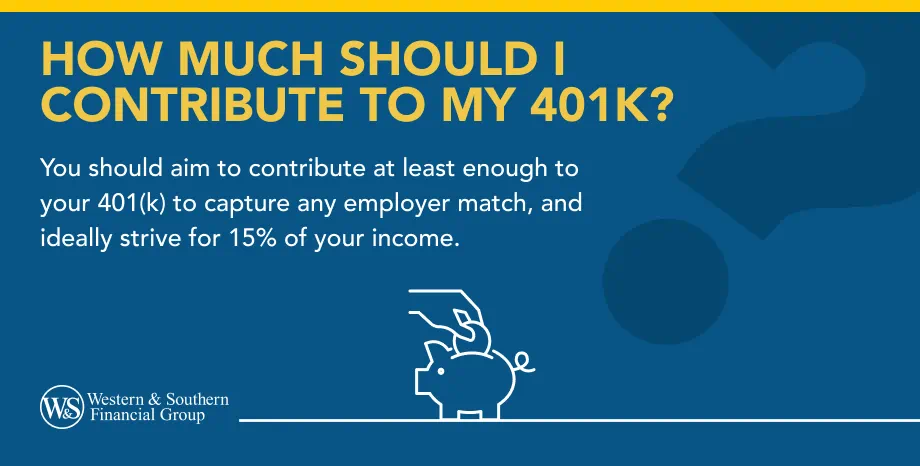Table of Contents
Table of Contents


Key Takeaways
- Contribute enough to your 401(k) to receive the full employer match.
- Gradually increase your contribution percentage over time, especially with pay raises.
- Consider other retirement accounts, like IRAs, when determining your total savings rate.
- Factors like retirement income needs, life expectancy, current savings, years until retirement, and risk tolerance influence the ideal contribution.
- Use online calculators or consult a financial professional to determine the right contribution percentage for your specific situation.
The percentage of income to save will depend on several factors. After taking these into consideration, you can make an informed decision about how much you should be saving for retirement.
Considerations Around Contributing to a 401(k)
Perhaps the most important question to ask yourself with regard to retirement planning is, "What percentage should I contribute to my 401(k)?" You may have heard that you should typically contribute at least 10% of your salary to your 401(k), but everyone's financial situation is different.1 For additional guidance, you can also review some general tips for contributing to a 401(k) plan.
Keep these considerations in mind when deciding how much to contribute to your 401(k):
Take Full Advantage of the Employer Match
If available, it's wise to always contribute enough to your 401(k) plan to receive the full matching contributions from your employer. For example, if your employer's 401(k) plan offers a 50% matching contribution up to 6% of your base salary, your 401(k) contribution percentage should be at least 6%.
Gradually Increase Your Contribution Percentage
It's generally a good idea to increase your 401(k) contribution percentage over time. For example, when you get a pay raise, consider giving your retirement savings a raise by increasing the percentage you contribute to your 401(k).
Factor in Other Retirement Accounts
Your total retirement savings rate will likely include retirement vehicles other than your 401(k), such as an individual retirement account (IRA). For example, if your target retirement savings rate is 20%, you can reach this goal by contributing 15% of income to your 401(k) and 5% of your income to an IRA, assuming you remain within the respective contribution limits.
Set your 401(k) contributions according to your financial situation and future goals. Start Your Free Plan
5 Factors That Can Affect Your 401(k) Savings Strategy
You can determine your ideal 401(k) contribution percentage with the help of online financial calculators or the guidance of a financial professional. No matter which resource you use, the right 401(k) contribution rate for you will depend on at least five primary factors:
1. How Much You'll Need to Retire
A common rule of thumb is that you'll need about 80% of your pre-retirement income in retirement.
2. How Long You Expect to Live
The number of years you'll need retirement income is a major determining factor in how much you'll need to retire. While no one knows exactly how long they'll live, you can make estimates based on your and your immediate family's health and longevity.
3. How Much You've Already Saved for Retirement
The higher your 401(k) balance, the less you'll generally need contribute to your 401(k) plan as you approach retirement. The lower your balance, the more you'll need to play catch up by contributing a higher percentage toward your retirement. To help determine how much your 401(k) could be worth over time, you can use a 401(k) growth calculator .
4. How Many Years You Have to Go Until Retirement
The more years you have left in the workforce, the longer you have to grow your retirement assets.
5. How Much Risk You Are Willing to Take With Investments
Higher risk investments can potentially produce higher returns over time compared with lower risk investments. Thus, all other factors being equal, you may not need to contribute as much to your 401(k) if you are willing to take on more risk. Adversely, if you want to take the low-risk route, you may need to compensate by contributing a higher percentage to your 401(k). Keep in mind that investments cannot guarantee growth or sustainment of principal value; they may lose value over time.
Secondary factors — such as Social Security income, rate of inflation, rate of return on investments, employer matching contributions and 401(k) contribution limits — can help to determine your ideal 401(k) contribution rate. After you figure the primary factors, a good retirement calculator can help you arrive at a closer estimate of how much you need to contribute to your 401(k).
Getting Help When You Need It
Along your retirement savings journey, when you find yourself reflecting on questions like "How much should I contribute to my 401(k)?" or "What percentage should I contribute to my 401(k)?" — remember to review these five factors and use financial calculators to help you make the right decision for your financial situation.
Additionally, you can always enlist the help of a financial professional to bring all of the planning elements together to determine the right 401(k) contribution percentage.
Maximize the potential of your 401(k) as part of your retirement plan. Start Your Free Plan
Sources
- How Much Should You Contribute to a 401(k)? https://money.usnews.com/money/retirement/401ks/articles/how-much-should-you-contribute-to-a-401-k.


















